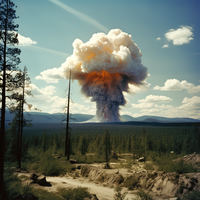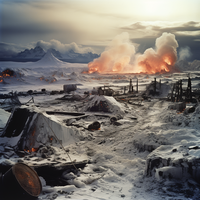History of Hergom: Difference between revisions
mNo edit summary |
|||
| Line 56: | Line 56: | ||
=== 7689 - Current Era === | === 7689 - Current Era === | ||
[[Category:History]] | |||
[[Category:Hergom]] | |||
Revision as of 03:33, 30 September 2023
Pre-Wolgos History
For much of its historical narrative, Kupeya remained ensconced within a realm of limited development. Its northern coast extended as a slender belt of temperate land, while the continent itself boasted a penchant for climatic variability that rendered its colder boreal interior inhospitable to pre-industrial societies.
Along this coastal fringe, a string of modest Chalam princedoms emerged over time, forming clusters of villages dependent upon subsistence farming and fishing. These entities occasionally engaged in trade with the warmer Raian archipelago, a connection that punctuated their existence.
Venturing further into the continent's heart revealed hunter-gatherer villages strewn across the landscape, punctuated occasionally by subsistence trading communities settled along the meandering banks of the continent's intricate river networks. The Phula and Alutean peninsula, in contrast, gave rise to societies of greater advancement, characterized by their capacity to erect permanent stone and earth mound temples. Within most of these villages and towns, palisades stood sentinel, and communal grain silos stored the bounty of the subtropical climate, offering these societies an abundance of crops.
Among these regions, Alutea stands as the sole recipient of Ithrien's colonial influence. Trading outposts and coastal holdings established by Ithrienian lords endowed Alutea with a more advanced societal landscape. In exchange for valuable commodities such as cassava, sea products, and even slaves, Alutea engaged in an exchange with Ithrien, elevating its position on the developmental spectrum.
Kupeya occupies a place of profound historical remoteness within the fabric of Gotha, a distinction shared only with central Davai. Its proximity to the southern polar cap shielded Kupeya from the classical hemisphere and its confinement by the dense Raian archipelago to the north have sealed its isolation. This archipelago, once a sprawling realm cloaked in rainforest and coastal cultures trading in spices and tropical treasures, bore witness to piracy and commerce.
Despite its geographic connection to Raia, the region bordering Kupeya has remained veiled in dense, nearly impenetrable rainforests. Consequently, the allure of colonization never extended its grasp here, untouched by the ambitions of both Anarians and Western Davai. Anarians mapped and explored the region but ultimately viewed it as less promising compared to the fertile colonial prospects of Altaia, D’runia, Tzeraka, and the Shangti.
7603 - 7620 - Second Wolgos Trek
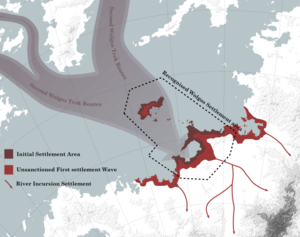
Following the tumultuous aftermath of the Wolgos Scourge, a profound transformation unfolded within Kupeya, catalyzed by what would come to be known as the Second Wolgos Trek. This phase of history witnessed the Peleykros peninsula becoming a converging point for an unparalleled influx of Wolgos migrants, reshaping the region's very fabric.
In the wake of the devastating Wolgos Scourge, the remnants of the once-mighty Bind navy and merchant marine embarked on a grand and audacious endeavor. This involved orchestrating an extensive logistical operation that aimed not only to relocate a vast number of people but also to transport vital machinery and equipment salvaged from the now-ravaged Altaia. To facilitate this ambitious migration, the Bind administration spared no expense, even to the point of financial ruin. They turned to Kamura and others for much-needed assistance, forming a coalition of resources to tackle this Herculean task.
Amid these transformative events, it's crucial to note that the Wolgos migration was not without financial repercussions. The Bind administration, in their determination to orchestrate this ambitious migration, expended significant resources, ultimately leading to their bankruptcy.

The logistical complexity of the migration was staggering, involving the movement of countless Wolgos individuals, often accompanied by their Shriaav allies. Over a span of fifteen years, this massive operation facilitated the transportation of approximately forty million Wolgos and three million Shriaav from Altaia to Kupeya, creating a phenomenon of unprecedented scope.
However, not all Wolgos were prepared to sever their connections with their adopted home. An estimated eight million Wolgos chose to remain in Altaia, displaying a deep attachment to the land despite the challenges that had befallen it. An additional two million Wolgos dispersed across the Shangti region, charting divergent paths amidst this epochal transformation.
For the Wolgos who remained behind, they encountered not only political and economic hurdles but also the weight of anti-Wolgos prejudices as a result of the war they had instigated. Despite these trials, over the following decades, they and their descendants made the decision to migrate to Kupeya, drawn by the promise of new beginnings and opportunities. Nevertheless, even as the majority found their way to Kupeya, over three million Wolgos remain scattered beyond the confines of Hergom.
The initial years in Kupeya were a crucible of trials. Struggles emerged as the Wolgos migrants confronted both the indigenous populations of the region and the scarcity of sustenance. The initial reliance on imported food resources gradually waned, further exacerbating the challenges faced by the newcomers.
As the availability of imports dwindled, the Wolgos community pivoted toward adapting to their new surroundings. The fertile expanse of the Wodranis river plains assumed a central role in this adaptation process. Here, a concerted effort unfolded, marked by the ravenous consumption of native wildlife and the indigenous inhabitants. These resources served as a lifeline, providing sustenance in the midst of change.
This era of transformation also bore witness to the rise of new infrastructural developments. The remaining fragments of the Bind administration moved swiftly to establish a rudimentary construction industry. Fishing ports emerged, along with the construction of docks along the Wodranis and Pleudhara rivers. These pivotal developments not only bolstered the burgeoning settlements but also streamlined the transportation of essential resources, particularly grains and sustenance, back to Ombhrosdhom. This evolving nucleus evolved into a thriving city at the heart of Kupeya's metamorphosis.
7608 Foundation of Hergom ep Swekorwos
7632 - 7634 First Coalition War


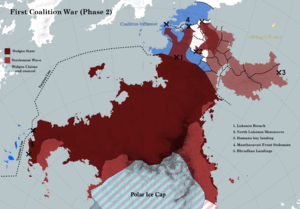
7663 - 7664 Second Coalition War
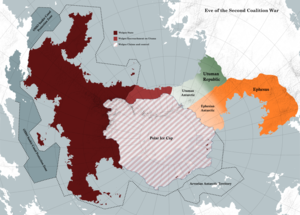
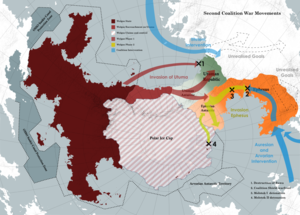
7664 - First use of nuclear weapons in Ephesus Front by the Coalition
